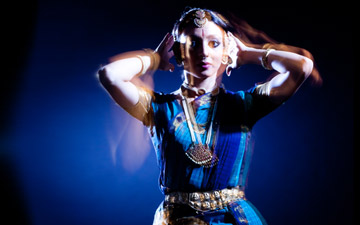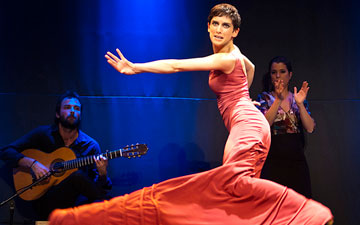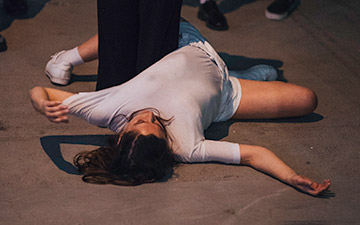
© Jesus Ubera. (Click image for larger version)
Pepa Ubera (curator)
Wild Card invites The Palest Light
Alice Chauchat: Togethering
Marco Florio: Sound Bath
Deniz Unal: INSTRUCTIONS FOR A PERFORMANCE: RESISTANCE AND CARE
Josefina Camus and Pepa Ubera: Ellipsis Land
★★★✰✰
London, Sadler’s Wells Lilian Baylis Studio
4 March 2016
pepaubera.com
www.sadlerswells.com
If the thought of getting out of your chair during a performance alarms you, Pepa Ubera’s The Palest Light is not the show for you. The production – an immersive assembly of music, dance and performance art commissioned as part of Sadler’s Wells’ Wild Card series – frequently calls for audience participation, both direct, as with the segment in which the audience ‘performs’ by following a set of instructions, and indirect, like one performer’s request that viewers “telepathically send” her a dance to execute. It’s a truly unusual 100 minutes, to say the least. The words ‘engaging’, ‘boggling’, and ‘bold’ also spring to mind.
The show’s setting was my first clue that it would be a departure from the average dance performance. I entered the Lilian Baylis Studio to find it transformed into a poolside club of sorts, the standard tiered seating replaced with patterned deck chairs and floor pillows, plants hanging from the ceiling and scattered in pots across the floor. The audience settled into this serene environment and the evening’s action took place around us, starting with a so-called ‘group solo’ from Berlin-based performer Alice Chauchat.
The ‘group’ element alludes to Chauchat’s embrace of choreography as a collective process – “both a means and an end to togetherness,” in her own words. Early on in her piece, a tangle of monologue and dance, she spoke about the shared space between a dancer and her audience, and the unique performance this facilitates, as different audiences exude different influences. Later, she invited us to join her as “both author and spectator” of her work, imploring us to “send” a dance for her to “receive and perform.”
While I found Chauchat’s musings somewhat wearing after 40 minutes, I remained drawn to her charming delivery, which saw her dole out lines like “If we honour our work together, we will be it and it will make us what we are” with a breezy smile that relieved them of their desperate grasp at profundity. Her fluid choreography – a buoyant stream of swishes and squiggles and gallops, all topped with excellent balance and turnout – was also a draw.

© Jesus Ubera. (Click image for larger version)
The programme’s next instalment, a 20-minute ‘sound bath’ of meditative music from Marco Florio, was pleasant and calming, while the one that followed – an interactive exercise in which we were asked to partner up with someone we didn’t know and carry out a series of increasingly strange actions on one another – boomeranged us (well, me at least) into total discomfort. (I’d like to say with authority that I wasn’t the only one uneasy touching a stranger’s waist, let alone “tonguing” their eyelash, but it was a pretty open-minded crowd.) Unwanted interactions aside, the offering felt a tad too removed from its author (Deniz Unal) for my taste – even our instructor was an audience volunteer – though I have to admit that as an experiment in performance it was pretty interesting, at least conceptually. In any case, it could do without the supplementary narration, which read like a warped meditation script (“Envision your internal organs as if wrapped in plastic”) and distracted from the ‘performance’ at hand.
I was much less equivocal about the evening’s closer, a charged, absorbing duet featuring Josefina Camus and Ubera herself, set to a turbulent score by Simone Salvatici. The two dancers started out facedown on the floor, an aerial view of them projected onto the back wall, and executed a choreography of furious squirms and fidgets that called to mind amoebas wriggling in a petri dish. Eventually the camera cut out and their live action replaced the projection as the point of focus. Over the next 20 minutes, they worked their way up to crouching and then standing, then stamped out a raucous shuffle of thrusting cores and skewed limbs. It’s a cryptic piece in both mood and tone, but the kind of cryptic that intrigues rather than bewilders. Coupled with its unfinished feel, this makes it easy to imagine it as a prelude to a much longer work.
While The Palest Light is not without its ups and downs, it’s exciting to see a venue as high-profile as Sadler’s Wells giving space to young, boundary-pushing choreographers like Ubera. Experimentation is an integral component to contemporary dance, and the programme’s performers, with their tireless exploration of what constitutes performance, have certainly shown they’re up for taking a gamble.

















You must be logged in to post a comment.